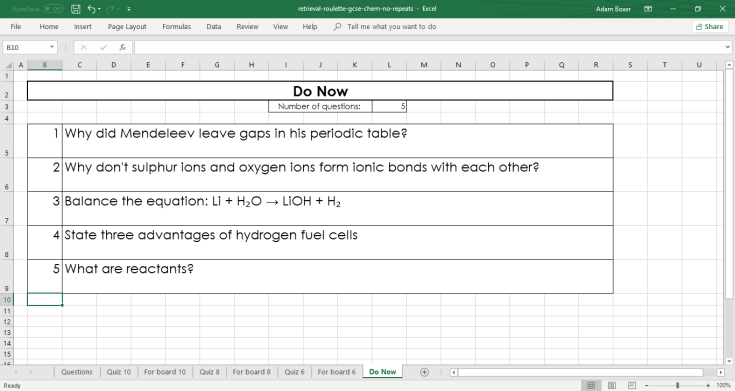
I’m really chuffed at the number of people who have got in touch to say they are using retrieval roulettes and that they are willing to share theirs. I use one in 90% of my lessons and in my opinion there are many benefits:
- It’s a great starter as not only is it a settling activity, but it’s actually beneficial to student memory, unlike other common starters (codebreakers and wordsearches: I’m looking at you).
- You also have the opportunity to destroy learned helplessness in your classes. You can give students the entire roulette (and I do), guaranteeing that with a little elbow grease they can score 100% in a test every lesson. For students who day in, day out, struggle with work and fail to access large parts of their studies, the motivational effects here can be huge.
- As above, I regularly send the roulette home via email to the students and their parents. A lot of my students want to revise for tests, but find themselves involved in ineffective practices like making posters, flashcards or beautifully highlighted notes. To be fair, why should they know any better? The roulette gives them a powerful tool which they can just sit down and get on with. Those with supportive home environments benefit further as it gives parents a way to effectively support their children. Wins all around.
- The fact that people share theirs mean that they are also workload busters. By centralising the resource, people can collaborate and develop a resource they can use frequently without having to worry about it. No printing, no forward planning – just load it up on the screen.
As a counter to point 4, I just want to mention how much I enjoy actually making them for myself. The act of taking an entire subject and breaking it down into tiny questions has been so powerful for my Pedagogical Content Knowledge. It’s really helped me understand the component parts of my subject, in a way that just reading a textbook or a specification haven’t done. As such, if you have the time, I really recommend you try and make one yourself.
I’ve written at length about the process of making questions like this here and here. In short, make sure that your questions:
- Have short answers: too long and you should probably break the question up into smaller chunks
- Are sequenced properly: try and have the ideas logically build one on top of the other. This will help you in your thinking about your subject and your students in their understanding of the bigger picture
- Have lean answers: try and use as few words in your answers as possible. Any superfluous words are just more things for students to remember
Happy rouletting! As ever, I would love to share your work so please let me know if you are willing.
December 13, 2018 at 4:56 am
Reblogged this on The Echo Chamber.
LikeLike
January 18, 2019 at 2:51 pm
I have been using them and introducing them to staff who struggle with coming up with questions, marvellous. I have been attempting to measure thier impact in different topics and overall use in classes with assessment with and without them and also with and without issuing core knowledge question lists at the start of each topic. Quite a large margin of difference i can tell you. thank you so much
LikeLiked by 1 person
January 18, 2019 at 2:54 pm
Glad to hear!
LikeLike